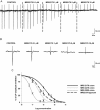Purinergic neuromuscular transmission in the gastrointestinal tract; functional basis for future clinical and pharmacological studies
- PMID: 24910216
- PMCID: PMC4209144
- DOI: 10.1111/bph.12802
Purinergic neuromuscular transmission in the gastrointestinal tract; functional basis for future clinical and pharmacological studies
Abstract
Nerve-mediated relaxation is necessary for the correct accomplishment of gastrointestinal (GI) motility. In the GI tract, NO and a purine are probably released by the same inhibitory motor neuron as inhibitory co-transmitters. The P2Y1 receptor has been recently identified as the receptor responsible for purinergic smooth muscle hyperpolarization and relaxation in the human gut. This finding has been confirmed in P2Y1 -deficient mice where purinergic neurotransmission is absent and transit time impaired. However, the mechanisms responsible for nerve-mediated relaxation, including the identification of the purinergic neurotransmitter(s) itself, are still debatable. Possibly different mechanisms of nerve-mediated relaxation are present in the GI tract. Functional demonstration of purinergic neuromuscular transmission has not been correlated with structural studies. Labelling of purinergic neurons is still experimental and is not performed in routine pathology studies from human samples, even when possible neuromuscular impairment is suspected. Accordingly, the contribution of purinergic neurotransmission in neuromuscular diseases affecting GI motility is not known. In this review, we have focused on the physiological mechanisms responsible for nerve-mediated purinergic relaxation providing the functional basis for possible future clinical and pharmacological studies on GI motility targeting purine receptors.
© 2014 The British Pharmacological Society.
Figures









Similar articles
-
P2Y1 purinoreceptors are fundamental to inhibitory motor control of murine colonic excitability and transit.J Physiol. 2012 Apr 15;590(8):1957-72. doi: 10.1113/jphysiol.2011.224634. Epub 2012 Feb 27. J Physiol. 2012. PMID: 22371476 Free PMC article.
-
Pharmacological characterization of purinergic inhibitory neuromuscular transmission in the human colon.Neurogastroenterol Motil. 2011 Aug;23(8):792-e338. doi: 10.1111/j.1365-2982.2011.01725.x. Epub 2011 May 17. Neurogastroenterol Motil. 2011. PMID: 21585621
-
Differential functional role of purinergic and nitrergic inhibitory cotransmitters in human colonic relaxation.Acta Physiol (Oxf). 2014 Dec;212(4):293-305. doi: 10.1111/apha.12408. Acta Physiol (Oxf). 2014. PMID: 25327170
-
Progress in understanding of inhibitory purinergic neuromuscular transmission in the gut.Neurogastroenterol Motil. 2013 Mar;25(3):203-7. doi: 10.1111/nmo.12090. Neurogastroenterol Motil. 2013. PMID: 23414428 Free PMC article. Review.
-
Mechanisms responsible for neuromuscular relaxation in the gastrointestinal tract.Rev Esp Enferm Dig. 2016 Nov;108(11):721-731. doi: 10.17235/reed.2016.4058/2015. Rev Esp Enferm Dig. 2016. PMID: 26938735 Review.
Cited by
-
Purinergic regulation of pulmonary vascular tone.Purinergic Signal. 2024 Dec;20(6):595-606. doi: 10.1007/s11302-024-10010-5. Epub 2024 May 7. Purinergic Signal. 2024. PMID: 38713328 Free PMC article. Review.
-
Pharmacological characterization of alpha adrenoceptor-mediated motor responses in the rat colon.Neurogastroenterol Motil. 2025 Jan;37(1):e14921. doi: 10.1111/nmo.14921. Epub 2024 Sep 30. Neurogastroenterol Motil. 2025. PMID: 39344996 Free PMC article.
-
Purinergic inhibitory regulation of esophageal smooth muscle is mediated by P2Y receptors and ATP-dependent potassium channels in rats.J Physiol Sci. 2024 Apr 23;74(1):26. doi: 10.1186/s12576-024-00916-5. J Physiol Sci. 2024. PMID: 38654149 Free PMC article.
-
ATP-Induced Contractile Response of Esophageal Smooth Muscle in Mice.Int J Mol Sci. 2024 Feb 6;25(4):1985. doi: 10.3390/ijms25041985. Int J Mol Sci. 2024. PMID: 38396664 Free PMC article.
-
Nitric Oxide Is Essential for Generating the Minute Rhythm Contraction Pattern in the Small Intestine, Likely via ICC-DMP.Front Neurosci. 2021 Jan 7;14:592664. doi: 10.3389/fnins.2020.592664. eCollection 2020. Front Neurosci. 2021. PMID: 33488345 Free PMC article.
References
Publication types
MeSH terms
Substances
LinkOut - more resources
Full Text Sources
Other Literature Sources

